Assessing Climate Change Impacts on Groundwater Recharge and Storage Using MODFLOW in the Akhangaran River Alluvial Aquifer, Eastern Uzbekistan
Abstract
1. Introduction
2. Study Area
2.1. General Setting
2.2. Hydrogeological Background
- -
- Upper quaternary and recent river alluvial deposits (aQIV): These deposits form the uppermost aquifer layer in the Akhangaran River Valley and floodplain terraces. In the Akhangaran–Nurabad area, the aquifer thickness ranges from 10.0 to 15.0 m. The sediments consist of sandy gravel and pebbles with occasional boulders. Hydraulic conductivity (K) ranges from 40.0–50.0 m/d to 100.0–200.0 m/d in recent alluvium, decreasing to 10.0 m/d in deeper layers dominated by sand and loam. Groundwater is fresh, with total dissolved solids (TDSs) up to 0.5 g/L.
- -
- Upper quaternary proluvial–alluvial deposits (paQIII): These deposits occur on floodplain terraces and side-valley alluvial fans. The sediments include sandy gravel and pebbles, interbedded with loam. Groundwater levels in side-valley fans range from 15.0 to 35.0 m below the ground surface. K values are heterogeneous, ranging from 0.2 m/d in loam to 10.0–30.0 m/d in pebbles. In loamy sand and pebbles, K values range from 0.4 to 4.8 m/d. Water is fresh (TDSs ≤ 0.5 g/L), and this unit serves as the primary source for groundwater abstraction.
- -
- Middle quaternary proluvial–alluvial deposits (paQII): This semi-confined to confined aquifer underlies the paQIII unit and consists of gravel interbedded with loess and loam. K values range from 0.2 to 1.2 m/d in loess and loam to 9.5–30.9 m/d in gravel. TDSs ranges from 1.6 to 6.0 g/L, indicating slightly to moderately saline water, with hardness levels between 510.0 and 2300.0 mg/L.
- -
- Lower quaternary proluvial–alluvial deposits (paQI): Although not well-documented in the Akhangaran River Valley, these deposits are known to occur in the Chirchik River Basin to the northwest. Their thickness ranges from 12.0 to 56.0 m up to 200.0 m. The sediments primarily consist of sandy gravel and pebbles, with K values between 5.0 and 17.0 m/d. The groundwater is fresh (TDSs ≤ 1.0 g/L) but exhibits high hardness, ranging from 150.0 to 300.0 mg/L.
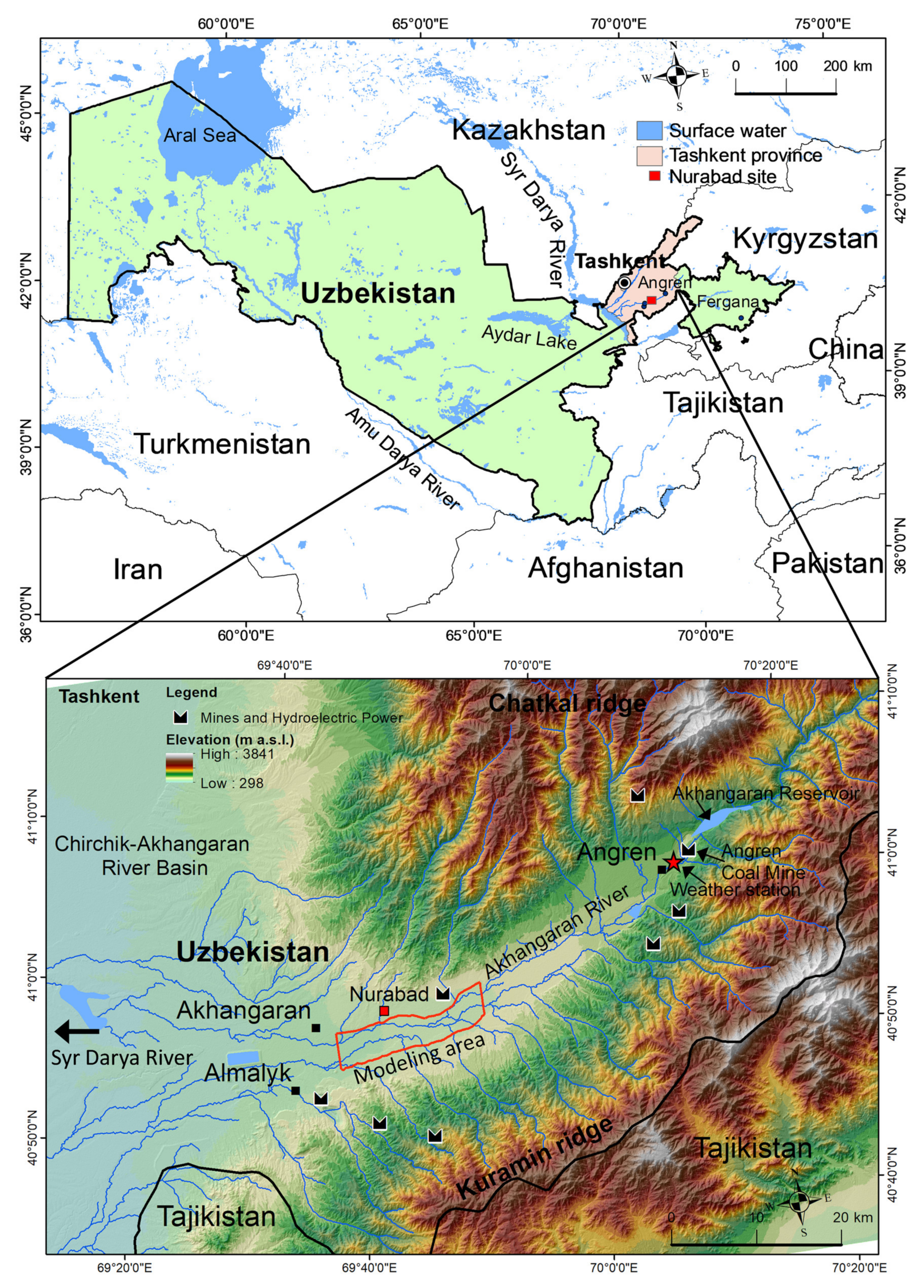
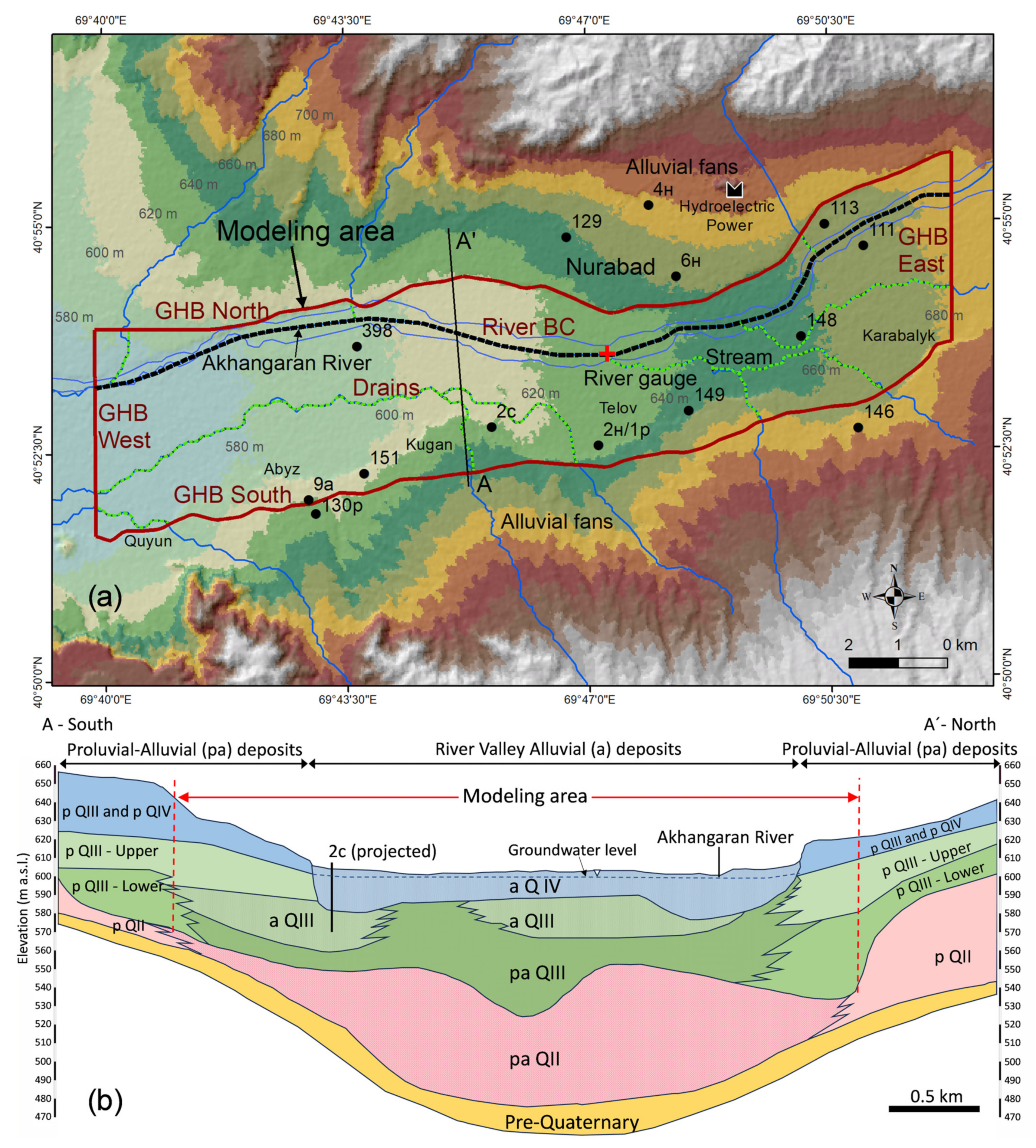
3. Materials and Methods
3.1. Hydrogeological Data
- Mean monthly groundwater levels from eight observation boreholes (2010–2020), used for steady-state model calibration.
- Monthly groundwater levels from five observation boreholes over the same period, used for transient model calibration.
3.2. Climate Data and Climate Scenarios
- -
- Simulated historical data for the period 1995–2014.
- -
- Scenario projections for 2020–2039, 2040–2059, 2060–2079, and 2080–2099.
3.3. Groundwater Flow Model
3.3.1. Model Discretization
3.3.2. Model Boundary Conditions and Hydraulic Parameters
3.3.3. Model Calibration
4. Results
4.1. Climate Variables and Potential Evapotranspiration (PET)
4.2. Model Calibrations
4.2.1. Steady-State Flow
4.2.2. Transient Flow During 2010–2020
4.3. Simulations of Climate Scenarios
4.3.1. Groundwater Recharge
4.3.2. Riverbed Infiltration
4.3.3. Drains
4.3.4. General Head Boundary (GHB) Fluxes
4.3.5. Change in Water Storage
4.4. Model Limitations
- -
- Several input parameters were held constant across all simulations, including groundwater pumping rates, mean monthly river stage elevations, and land use patterns. These parameters are subject to change over time and may significantly influence groundwater recharge and storage estimates.
- -
- Although the model was successfully calibrated against available groundwater level measurements, key boundary conditions remain uncertain. For example, the side-valley alluvial deposits represented by the GHB in the southern part of the domain currently show a disproportionately high contribution to the water budget. Similarly, the river boundary conditions are uncertain due to the lack of concurrent measurements of river stage and groundwater levels, making it difficult to accurately characterize river and aquifer interactions.
- -
- The groundwater level data used for calibration were collected on a monthly basis, and no river stage or stream discharge data were available for the corresponding period.
- -
- Due to the absence of stream discharge measurements, streamflow-related outputs were derived solely from model simulations based on assumptions, thereby increasing the uncertainty of the results.
5. Discussion
5.1. Components of Water Budget
5.2. Impacts of Climate Change Scenarios on Groundwater Resources
6. Conclusions
Author Contributions
Funding
Data Availability Statement
Acknowledgments
Conflicts of Interest
References
- Beck, H.E.; Zimmermann, N.E.; McVicar, T.R.; Vergopolan, N.; Berg, A.; Wood, E.F. Present and future Köppen-Geiger climate classification maps at 1-km resolution. Sci. Data 2020, 7, 274. [Google Scholar] [CrossRef]
- Hu, Q.; Han, Z. Northward expansion of desert climate in Central Asia in recent decades. Geophys. Res. Lett. 2022, 49, e2022GL098895. [Google Scholar] [CrossRef]
- Hoegh-Guldberg, O.; Jacob, D.; Taylor, M.; Bindi, M.; Brown, S.; Camilloni, I.; Diedhiou, A.; Djalante, R.; Ebi, K.L.; Engelbrecht, F.; et al. Impacts of 1.5 °C Global Warming on Natural and Human Systems. In Global Warming of 1.5 °C. An IPCC Special Report on the Impacts of Global Warming of 1.5 °C Above Pre-Industrial Levels and Related Global Greenhouse Gas Emission Pathways, in the Context of Strengthening the Global Response to the Threat of Climate Change, Sustainable Development, and Efforts to Eradicate Poverty; Masson-Delmotte, V., Zhai, P., Pörtner, H.-O., Roberts, D., Skea, J., Shukla, P.R., Pirani, A., Moufouma-Okia, W., Péan, C., Pidcock, R., et al., Eds.; Cambridge University Press: Cambridge, UK; New York, NY, USA, 2018; pp. 175–312. [Google Scholar] [CrossRef]
- Fallah, B.; Didovets, I.; Rostami, M.; Hamidi, M. Climate change impacts on Central Asia: Trends, extremes and future projections. Int. J. Climatol. 2024, 44, 3191–3213. [Google Scholar] [CrossRef]
- The World Bank Group and the Asian Development Bank. Climate Risk Country Profile: Uzbekistan. 2021. Available online: https://www.adb.org/sites/default/files/publication/736686/climate-risk-country-profile-uzbekistan.pdf (accessed on 11 June 2023).
- Gafforov, K.S.; Bao, A.; Rakhimov, S.; Liu, T.; Abdullaev, F.; Jiang, L.; Durdiev, K.; Duulatov, E.; Rakhimova, M.; Mukanov, Y. The Assessment of Climate Change on Rainfall-Runoff Erosivity in the Chirchik–Akhangaran Basin, Uzbekistan. Sustainability 2020, 12, 3369. [Google Scholar] [CrossRef]
- Punkari, M.; Droogers, P.; Immerzeel, W.; Korhonen, N.; Lutz, A.; Venäläinen, A. Climate Change and Sustainable Water Management in Central Asia; Asian Development Bank. 2014. Available online: https://www.adb.org/sites/default/files/publication/42416/cwa-wp-005.pdf (accessed on 11 June 2023).
- Abdullaev, B.D.; Andreev, D.N. To the Question of the Device of Water deposits of the Gallery Type on the Wells of the Sartamgala Plot (in Russia with English summary). Sci. New Technol. Innov. Kyrg. J. 2019, 4, 201–204. Available online: http://www.science-journal.kg/media/Papers/nntiik/2019/4/201-204.pdf (accessed on 27 March 2023).
- Sobirovich, F.A.; Turdikulovich, K.S. The use of water resources in the Akhangaran Basin in the Almalyk-Akhangaran Industrial Region. Nat. Sci. 2022, 20, 44–51. [Google Scholar]
- Weather and Climate. The Global Historical Weather and Climate Data: Historical Weather Data from January 2010–December 2020. Available online: https://weatherandclimate.com/uzbekistan/tashkent/angren (accessed on 20 October 2024).
- Luoma, S.; Okkonen, J. Impacts of Future Climate Change and Baltic Sea Level Rise on Groundwater Recharge, Groundwater Levels, and Surface Leakage in the Hanko Aquifer in Southern Finland. Water 2014, 6, 3671–3700. [Google Scholar] [CrossRef]
- Okkonen, J.; Kløve, B. A sequential modeling approach to assess groundwater-surface water resources in a snow dominated region of Finland. J. Hydrol. 2011, 411, 91–107. [Google Scholar] [CrossRef]
- Scibek, J.; Allen, D.M. Modeled Impacts of Predicted Climate Change on Recharge and Groundwater Levels. Water Resour. Res. 2006, 42, 1–18. [Google Scholar] [CrossRef]
- Jyrkama, M.I.; Sykes, J.F.; Normani, S.D. Recharge estimation for transient ground water modelling. Ground Water 2002, 40, 639–649. [Google Scholar] [CrossRef]
- Luoma, S.; Majaniemi, J.; Pullinen, A.; Mursu, J.; Virtasalo, J.J. Geological and groundwater flow model of a submarine groundwater discharge site at Hanko (Finland), northern Baltic Sea. Hydrogeol. J. 2021, 29, 1279–1297. [Google Scholar] [CrossRef]
- Rakhmatova, N.; Nishonov, B.E.; Kholmatjanov, B.M.; Rakhmatova, V.; Toderich, K.N.; Khasankhanova, G.M.; Shardakova, L.; Khujanazarov, T.; Ungalov, A.N.; Belikov, D.A. Assessing the Potential Impacts of Climate Change on Drought in Uzbekistan: Findings from RCP and SSP Scenarios. Atmosphere 2024, 15, 866. [Google Scholar] [CrossRef]
- Hamidov, A.; Khamidov, M.; Ishchanov, J. Impact of Climate Change on Groundwater Management in the Northwestern Part of Uzbekistan. Agronomy 2020, 10, 1173. [Google Scholar] [CrossRef]
- Kulmatov, R.; Groll, M.; Rasulov, A.; Soliev, I.; Romic, M. Status quo and present challenges of the sustainable use and management of water and land resources in Central Asian irrigation zones—The example of the Navoi region (Uzbekistan). Quat. Int. 2018, 464, 396–410. [Google Scholar] [CrossRef]
- Rakhmatullaev, S.; Huneau, F.; Kazbekov, J.; Celle-Jeanton, H.; Motelica-Heino, M.; Coustumer, P.L.; Jumanov, J. Groundwater resources of Uzbekistan: An environmental and operational overview. Cent. Eur. J. Geosci. 2012, 4, 67–80. [Google Scholar] [CrossRef]
- Ibrakhimov, M.; Martius, C.; Lamers, J.P.A.; Tischbein, B. The dynamics of groundwater table and salinity over 17 years in Khorezm, Uzbekistan. Agric. Water Manag. 2011, 101, 52–61. [Google Scholar] [CrossRef]
- Rysbekov, Y. Analysis of water management organizations in Chirchik-Akhangaran river basin (Central Asia): 1. Chirchik-Akhangaran basin water resources (CHAB). In A Regional Model for Integrated Water Management in Twinned River Basins “RIVERTWIN”, Tashkent; Dukhovny, V.A., Ed.; Publications in open sources; SIC ICWC: Tashkent, Uzbekistan, 2008; p. 188. Available online: http://www.cawater-info.net/rivertwin/documents/monograph.htm (accessed on 20 October 2024).
- Asian Development Bank. Uzbekistan: Second Tashkent Province Water Supply Development Project. Initial Environmental Examination (June 2018). Available online: https://www.adb.org/sites/default/files/project-documents/51240/51240-001-iee-en.pdf (accessed on 28 July 2023).
- Golovanov, I.M.; Seltmann, R.; Kremenetsky, A.A. The Porphyry Cu-Au/Mo Deposits of Central Eurasia: 2 The Almalyk (Kal’makry-Dalnee) and Saukbulak Cu-Au Porphyry Systems, Uzbekistan. In Super Porphyry Copper & Gold Deposits: A Global Perspective; Porter, T.M., Ed.; PGC Publishing: Adelaide, Australia, 2005; Volume 2, pp. 513–523. [Google Scholar]
- GIBB and SMEC. Aral Sea Basin Program Water and Environmental Management Project, Component C: Dam Safety and Reservoir Management, Akhangaran Dam Safety Assessment Report; LAWGIBB Group Member and SMEC: Tashkent, Uzbekistan, 2000; p. 39. Available online: http://www.cawater-info.net/bk/dam-safety/files/akhangaran-dam-en.pdf (accessed on 11 June 2023).
- DIVA-GIS. Free, Simple and Effective Spatial Data. Available online: https://diva-gis.org/data.html (accessed on 28 July 2023).
- USGS Earth Explorer. The Shuttle Radar Topography Mission (SRTM) Digital Elevation Model Data, US Geological Survey. Available online: https://earthexplorer.usgs.gov (accessed on 11 June 2023).
- Eyring, V.; Bony, S.; Meehl, G.A.; Senior, C.A.; Stevens, B.; Stouffer, R.J.; Taylor, K.E. Overview of the Coupled Model Intercomparison Project Phase 6 (CMIP6) experimental design and organization. Geosci. Model Dev. 2016, 9, 1937–1958. [Google Scholar] [CrossRef]
- IPCC. Summary for Policymakers. In Climate Change 2021: The Physical Science Basis. Contribution of Working Group I to the Sixth Assessment Report of the Intergovernmental Panel on Climate Change; Masson-Delmotte, V., Zhai, P., Pirani, A., Connors, S.L., Péan, C., Berger, S., Caud, N., Chen, Y., Goldfarb, L., Gomis, M.I., et al., Eds.; Cambridge University Press: Cambridge, UK; New York, NY, USA, 2021. [Google Scholar] [CrossRef]
- World Bank, Climate Change Knowledge Portal. Country: Uzbekistan, Current and Projections Climate Data. Available online: https://climateknowledgeportal.worldbank.org/country/uzbekistan (accessed on 20 October 2024).
- Copernicus Climate Change Service. The 2024 Annual Climate Summary: Global Climate Highlights on 17th January 2025. Available online: https://climate.copernicus.eu/global-climate-highlights-2024 (accessed on 20 January 2025).
- Harbaugh, A.W.; Langevin, C.D.; Hughes, J.D.; Niswonger, R.N.; Konikow, L.F. MODFLOW-2005, the U.S. Geological Survey Modular Groundwater Model, Version 1.12.00; U.S. Geological Survey Software Release, 3 February 2017; U.S. Geological Survey: Reston, VA, USA, 2017. [Google Scholar] [CrossRef]
- Hamon, R.W. Computational of Direct Runoff Amounts from Storm Rainfall; International Association of Scientific Hydrology Publication: Wallingford, Oxon, UK, 1963; Volume 63, pp. 52–62. [Google Scholar]
- Freeze, R.A.; Cherry, J.A. Groundwater; Prentice-Hall Inc.: Englewood Cliffs, NJ, USA, 1979; Volume 7632, p. 604. [Google Scholar]
- Doherty, J. PEST–Model-Independent Parameter Estimation–User’s Manual, 5th ed.; Watermark Numerical Computing: Brisbane, Australia, 2010; p. 336. [Google Scholar]
- Gracheva, I.N.; (Uzbekhydrogeology, Tashkent, Uzbekistan). Personal communication, 2024.
- Bristow, E.L.; Davis, K.W. Groundwater Flow Model for the Des Moines River Alluvial Aquifer Near Des Moines, Iowa, U.S. Geological Survey Scientific Investigations Report 2024–5059; U.S. Geological Survey: Reston, VA, USA, 2024; p. 47. [Google Scholar] [CrossRef]
- Okanagan Water Stewardship Council. Okanagan Alluvial Fan Hydrology: A Primer; Okanagan Basin Water Board: Kelowna, BC, Canada, 2023; p. 59. Available online: https://www.obwb.ca/alluvial (accessed on 9 February 2025).
- Mather, A.E.; Stokes, M.; Whitfield, E. River terraces and alluvial fans: The case for an integrated Quaternary fluvial archive. Quat. Sci. Rev. 2017, 166, 74–90. [Google Scholar] [CrossRef]
- Abesser, C.; Shand, P.; Gooddy, D.; Peach, D. The role of alluvial valley deposits in groundwater–surface water exchange in a Chalk river. In Groundwater–Surface Water Interaction: Process Understanding, Conceptualization and Modelling, Proceedings of the Symposium HS1002 at IUGG 2007, Perugia, Italy, 2–13 July 2007; IAHS Publication No 321; IAHS: Wallingford, UK, 2008; Available online: https://nora.nerc.ac.uk/id/eprint/5561/1/06_11-20_9_Abesser.pdf (accessed on 10 February 2025).
- Florsheim, J.L. Side-valley tributary fans in high-energy river floodplain environments: Sediment sources and depositional processes, Navarro River basin, California. GSA Bull. 2004, 116, 923–937. [Google Scholar] [CrossRef]
- Manning, A.; Julian, J.P.; Doyle, M.W. Riparian vegetation as an indicator of stream channel presence and connectivity in arid environments. J. Arid. Environ. 2020, 178, 104167. [Google Scholar] [CrossRef]
- Brkic, Z. Increasing water temperature of the largest freshwater lake on the Mediterranean islands as an indicator of global warming. Heliyon 2023, 9, e19248. [Google Scholar] [CrossRef]
- Khasanov, K. A comprehensive analysis of reservoir capacity loss: A case study of the Akhangaran Reservoir, Uzbekistan. Water Cycle 2024, 6, 105–117. [Google Scholar] [CrossRef]
- Deshmukh, M.M.; Elbeltagi, A.; Kouadri, S. Climate Change Impact on Groundwater Resources in Semi-arid Regions. In Climate Change Impact on Groundwater Resources; Panneerselvam, B., Pande, C.B., Muniraj, K., Balasubramanian, A., Ravichandran, N., Eds.; Springer: Cham, Switzerland, 2022; pp. 9–23. [Google Scholar] [CrossRef]
- Davamani, V.; John, J.E.; Poornachandhra, C.; Gopalakrishnan, B.; Arulmani, S.; Parameswari, E.; Santhosh, A.; Srinivasulu, A.; Lal, A.; Naidu, R. A Critical Review of Climate Change Impacts on Groundwater Resources: A Focus on the Current Status, Future Possibilities, and Role of Simulation Models. Atmosphere 2024, 15, 122. [Google Scholar] [CrossRef]
- Turkeltaub, T.; Bel, G. Changes in mean evapotranspiration dominate groundwater recharge in semi-arid regions. Hydrol. Earth Syst. Sci. 2024, 28, 4263–4274. [Google Scholar] [CrossRef]
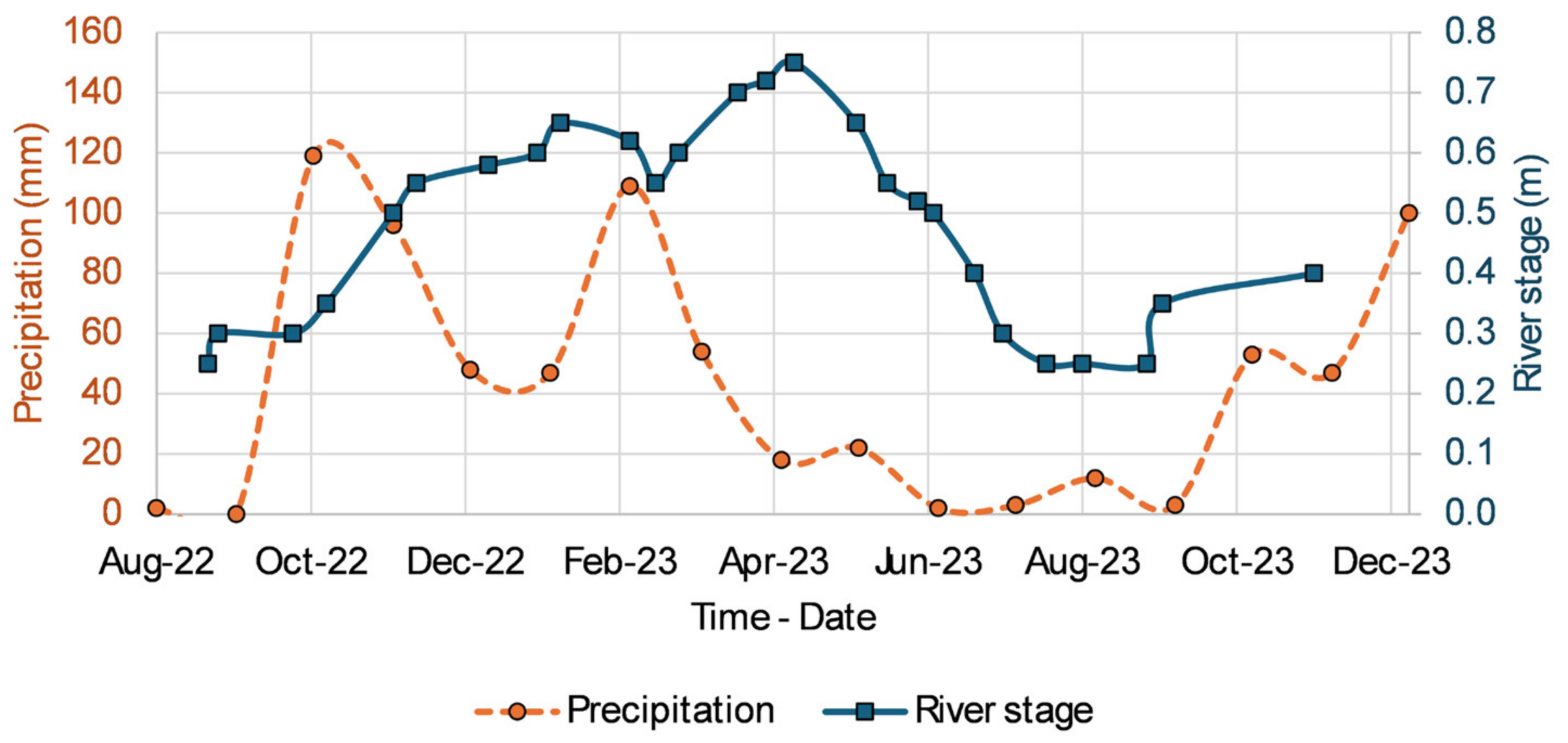
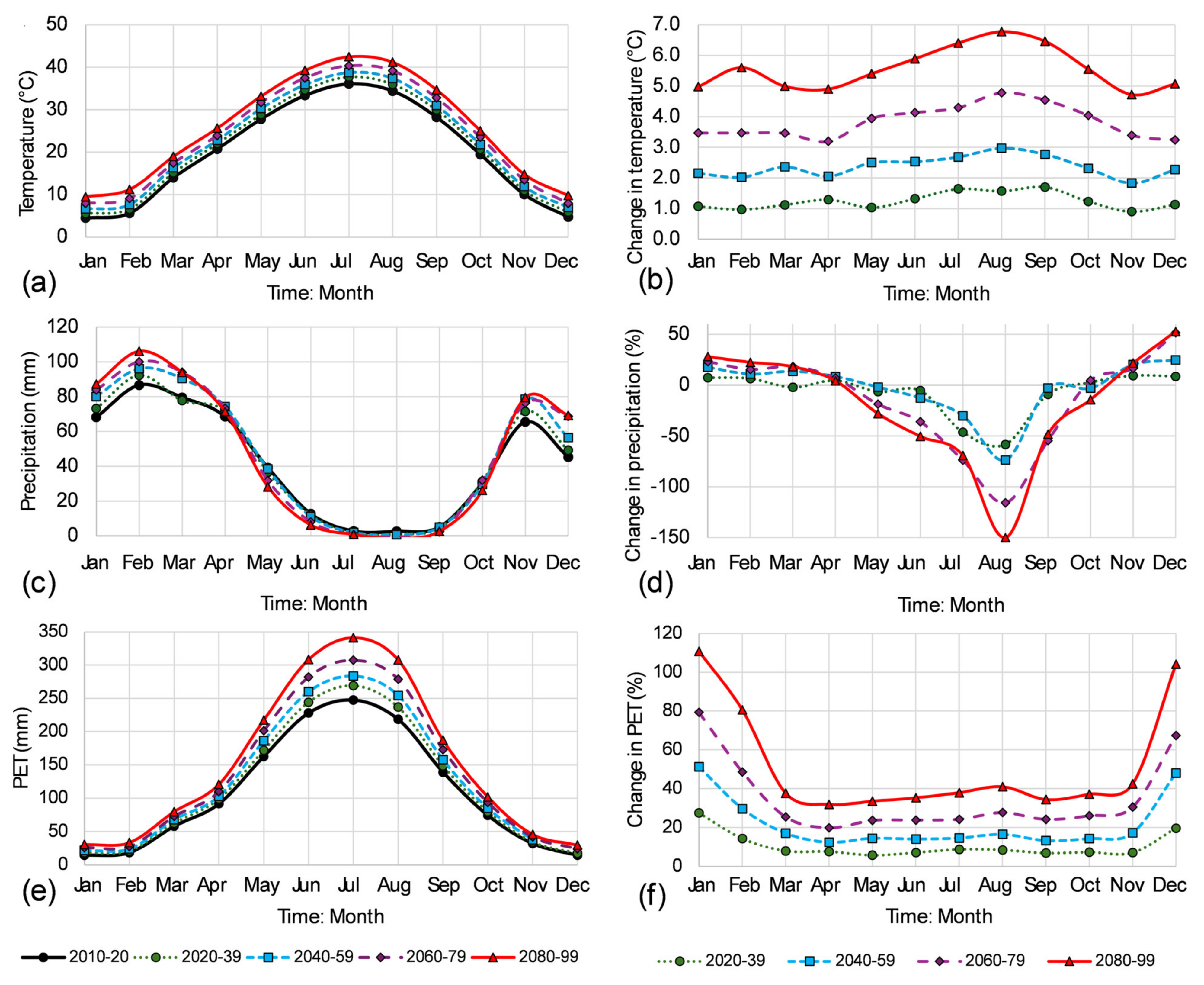

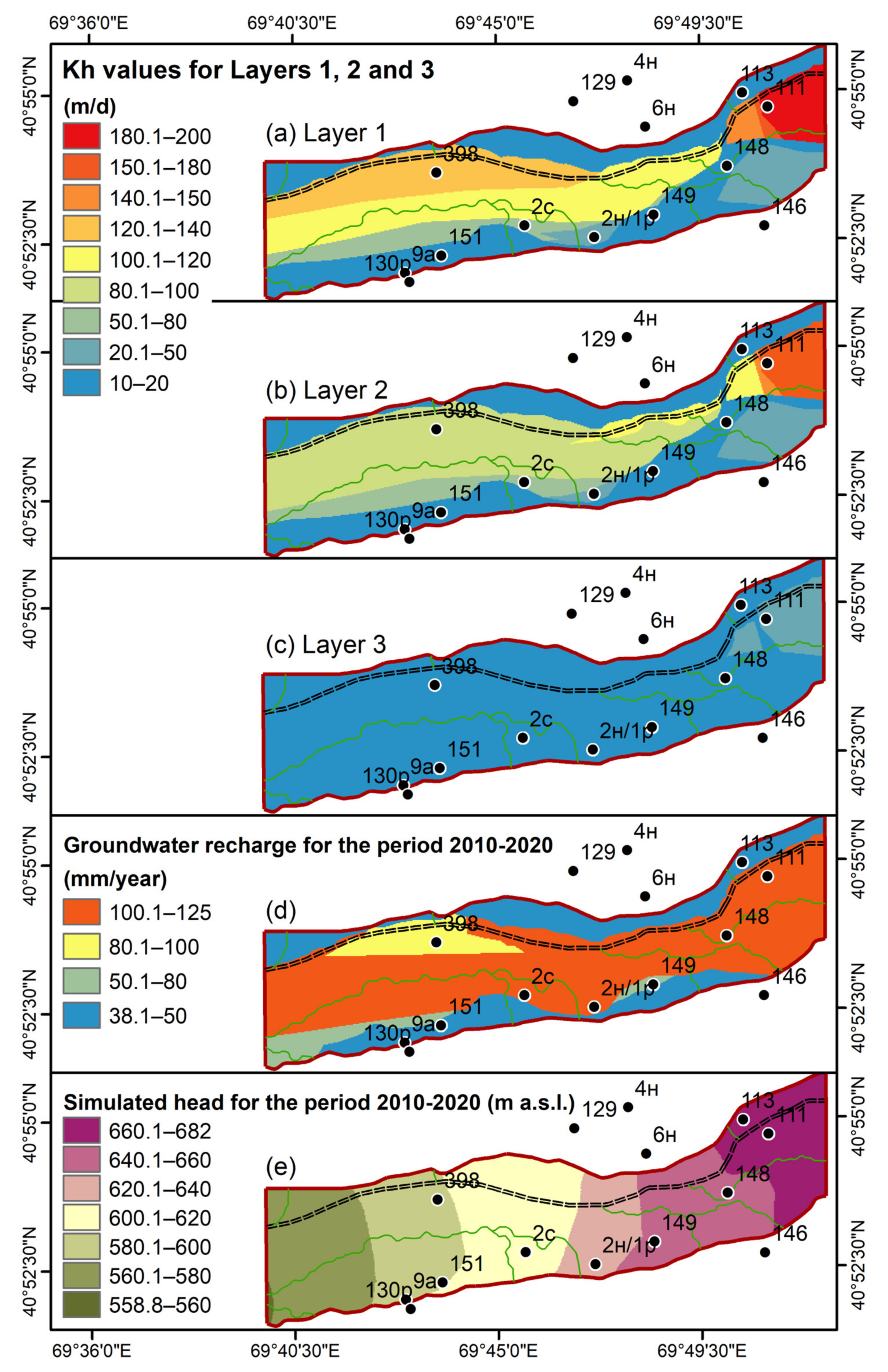
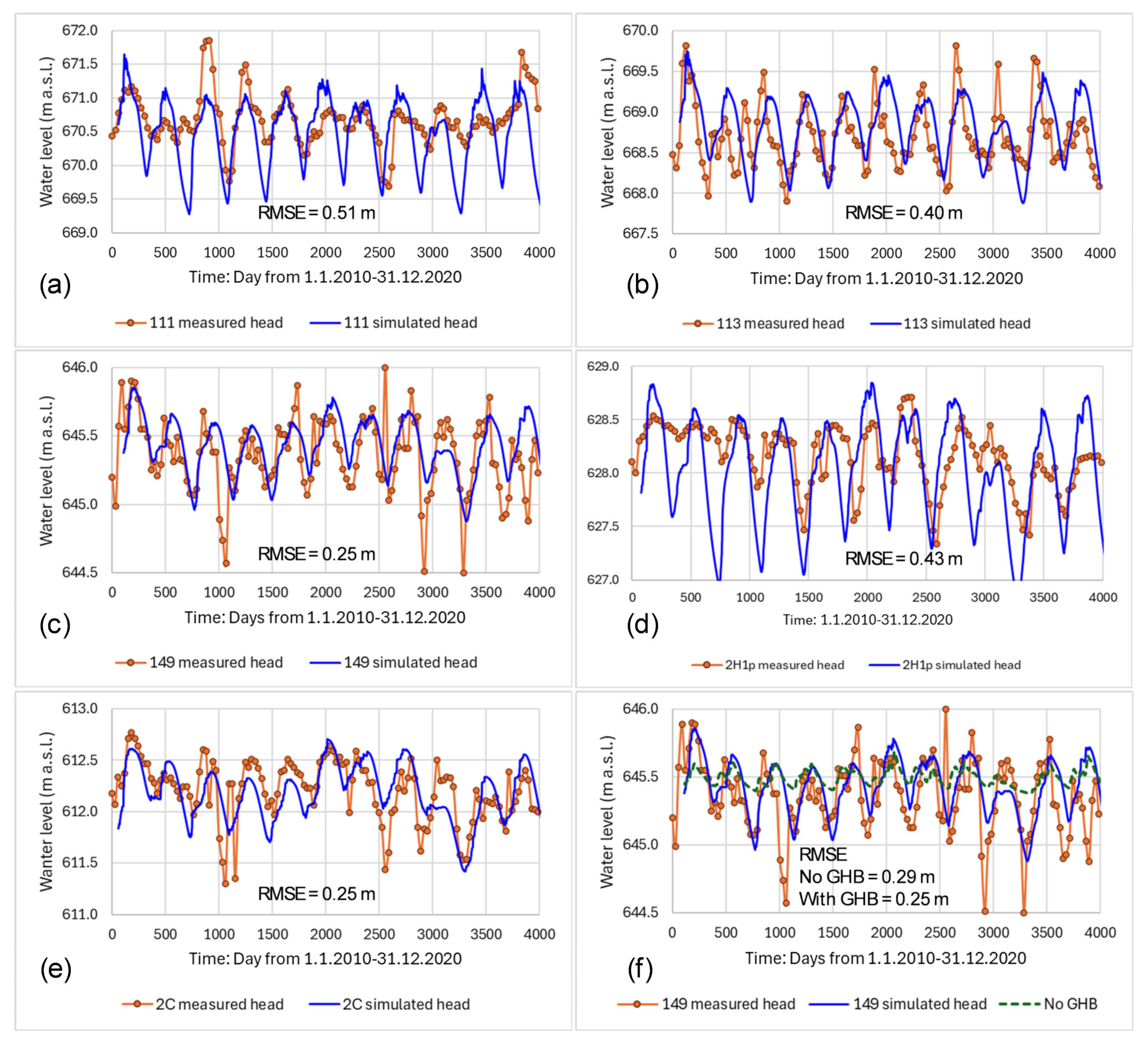





| Boundary | Inflow (m3/d) | Outflow (m3/d) | Inflow (%) | Outflow (%) |
|---|---|---|---|---|
| Pumping (Well) | 0 | 111,577.0 | 0 | 51.3 |
| Recharge | 14,937.7 | 0 | 6.9 | 0 |
| River | 9784.6 | 15,100.6 | 4.5 | 6.9 |
| Drains | 0 | 1304.2 | 0.6 | |
| GHB North | 9453 | 0 | 4.3 | 0 |
| GHB South | 70,529.5 | 0 | 32.4 | 0 |
| GHB East | 112,745.8 | 0 | 51.8 | 0 |
| GHB West | 0 | 89,468.6 | 0 | 41.1 |
| Total | 217,450.6 | 217,450.4 | 100 | 100 |
| In–Out (m3/d) | 0.2 | |||
| Difference (%) | 0.0001 |
Disclaimer/Publisher’s Note: The statements, opinions and data contained in all publications are solely those of the individual author(s) and contributor(s) and not of MDPI and/or the editor(s). MDPI and/or the editor(s) disclaim responsibility for any injury to people or property resulting from any ideas, methods, instructions or products referred to in the content. |
© 2025 by the authors. Licensee MDPI, Basel, Switzerland. This article is an open access article distributed under the terms and conditions of the Creative Commons Attribution (CC BY) license (https://creativecommons.org/licenses/by/4.0/).
Share and Cite
Kadirkhodjaev, A.; Andreev, D.; Akramov, B.; Abdullaev, B.; Abdujalilova, Z.; Umarova, Z.; Nazipova, D.; Ruzimov, I.; Toshev, S.; Anorboev, E.; et al. Assessing Climate Change Impacts on Groundwater Recharge and Storage Using MODFLOW in the Akhangaran River Alluvial Aquifer, Eastern Uzbekistan. Water 2025, 17, 2291. https://doi.org/10.3390/w17152291
Kadirkhodjaev A, Andreev D, Akramov B, Abdullaev B, Abdujalilova Z, Umarova Z, Nazipova D, Ruzimov I, Toshev S, Anorboev E, et al. Assessing Climate Change Impacts on Groundwater Recharge and Storage Using MODFLOW in the Akhangaran River Alluvial Aquifer, Eastern Uzbekistan. Water. 2025; 17(15):2291. https://doi.org/10.3390/w17152291
Chicago/Turabian StyleKadirkhodjaev, Azam, Dmitriy Andreev, Botir Akramov, Botirjon Abdullaev, Zilola Abdujalilova, Zulkhumar Umarova, Dilfuza Nazipova, Izzatullo Ruzimov, Shakhriyor Toshev, Erkin Anorboev, and et al. 2025. "Assessing Climate Change Impacts on Groundwater Recharge and Storage Using MODFLOW in the Akhangaran River Alluvial Aquifer, Eastern Uzbekistan" Water 17, no. 15: 2291. https://doi.org/10.3390/w17152291
APA StyleKadirkhodjaev, A., Andreev, D., Akramov, B., Abdullaev, B., Abdujalilova, Z., Umarova, Z., Nazipova, D., Ruzimov, I., Toshev, S., Anorboev, E., Rakhimov, N., Mamirov, F., Gracheva, I., & Luoma, S. (2025). Assessing Climate Change Impacts on Groundwater Recharge and Storage Using MODFLOW in the Akhangaran River Alluvial Aquifer, Eastern Uzbekistan. Water, 17(15), 2291. https://doi.org/10.3390/w17152291








